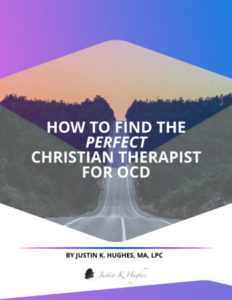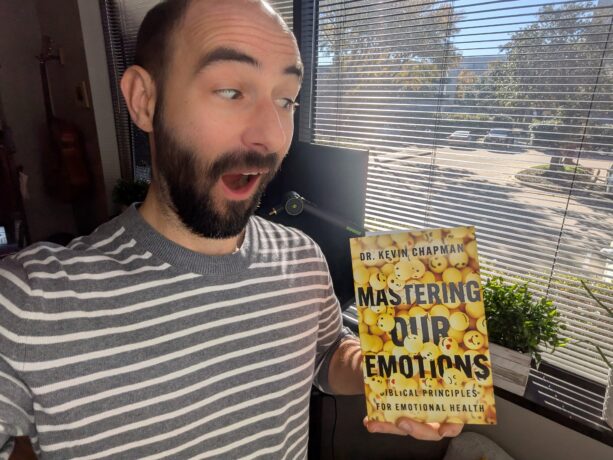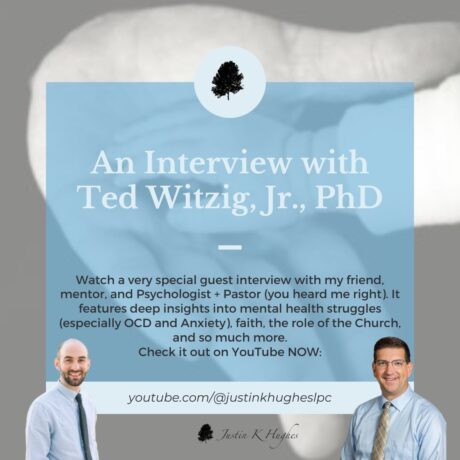
This article is part of a series written for mental health providers treating OCD. It can be found with minor edits on the International OCD Foundation’s Faith & OCD page.
Integrating a person’s faith into their therapy isn’t overly complex- it takes intentionality and care, which, if you are a licensed clinician- you hopefully possess skills already because of your training.
Your Client Is Who You Work For
While part of clinical work requires addressing areas the client doesn’t see or lacks desired change, we let clients guide and coach us on their experience. Clients are who we work for in the end. As noted in the “7 Competency Keys” in my first article, there is no reason to place less importance or emphasis on R/S matters when the client wishes to. Clinicians- in being aware of your own bias, don’t avoid talking about these topics simply because of your own discomfort. That is, of course, countertransference.
Follow Your Ethical Board
There are certain core ingredients most ethics boards or professional organizations share. Whether you’re in Texas or Massachusetts, Spain or Brazil, or are a psychologist or social worker, or professional counselor, when in doubt about actual hard-and-fast rules and laws, consult your board and/or an attorney. But for most day-to-day considerations, we must think autonomously for each client, in each case, based on our training and ethical requirements.
Ask Attentive Questions
We can miss illuminating a client’s incongruence between state beliefs and daily practice. For example, it is common in general therapy and treatment for OCD for a client to feel dissonance over what they ultimately want and what at the moment captures their attention. Of all counseling theories, CBT deals with this directly in Cognitive Restructuring. If a person is to challenge their thoughts and beliefs and restructure them to be realistic, how do we help clients do this if we’re spiritually avoidant? Ask good questions. Ask relevant questions. Ask the client how to ask them questions.
Treat OCD With CBT/ERP First
This possibly goes without saying for most clinicians on this site, but it’s an important reminder- treating OCD from a therapeutic first line means utilizing CBT & ERP. Assessment of this approach then requires considering the framework of CBT. “Therapist drift” can occur when clients and clinicians get comfortable and/or feel okay. Still, the provider must continue examining how this fits into the larger treatment plan.
Utilize A Robust Consent Process
When assessing and/or addressing any core domain in treatment, always ask for permission and gain consent paperwork and throughout treatment to ensure a client’s best interests are being served. Remember that changes also occur as a process for a reason. And if there is an evidence-based or R/S-congruent consideration for that client, ensure they have been given an appropriate opportunity to address how their belief and/or practice is a part of their life and/or how they wish it to be.
Only Thoughtfully Self-Disclose Appropriate To Treatment
By the nature of therapy and developing a working alliance, clients are often inquisitive about their providers in various ways. Sometimes details about the provider personally is what makes or breaks their decision for treatment. This is not necessarily problematic.
Technically speaking, even self-disclosure that a clinician has a diagnosis of OCD or any other diagnosis is still self-disclosure. Such sharing is to be thoughtful and not violate boundaries. However, when its use is ethical and further advances a client’s treatment (e.g., knowing it’s possible to be successful and have OCD to encourage someone suffering), there is much backing for this, though a clinician’s skill is a significant moderator of whether this is helpful or not. Much uncertainty about applying R/S into therapy centers on how it could have adverse impacts.
Keeping it simple: if there are religious and spiritual matters a clinician doesn’t have a theoretical or therapeutic defense for sharing, it’s best kept to themselves.
You Don’t Have To Practice Clients’ R/S Approaches
Critical reminder: as clinicians, most of us work with many different backgrounds. You DON’T have to practice or believe the R/S approaches of a client. You have hopefully already covered this reasonably extensively in your training and how to approach when someone differs from you. As clinicians, we must constantly be growing towards awareness of our own biases, and beliefs, and how to help clients in the best way for them. But it bears reminding: you can help another person live congruently even when you approach it differently.
Train Clients To Be assertive For Their Needs- Watch For Unhelpful Dependencies
The IOCDF has a beautiful article on “How To Find The Right Therapist.” We can extrapolate many of the principles to locate a therapist who respects your diversity, culture, and religion/spirituality. You can also find two free ebooks on the topic by subscribing to my free newsletter.

 Clients ideally need the skills to be assertive in the therapy process for their success, so you might have to prompt a client at the beginning as to whether their faith/religion/etc. pertains to the therapy session, helping them take the initiative over time to connect the dots where necessary is crucial.
Clients ideally need the skills to be assertive in the therapy process for their success, so you might have to prompt a client at the beginning as to whether their faith/religion/etc. pertains to the therapy session, helping them take the initiative over time to connect the dots where necessary is crucial.
Particularly with Obsessive Compulsive Disorder, we cannot underestimate the amount of secondary reassurance that occurs simply by the presence of someone else who is known to think/believe a certain way. This is inevitable at some point- many clients are reassured, for instance, when they state they fear losing their mind or killing someone when the therapist does not respond to what has been deemed an intrusion. However, over time, minimizing and eliminating this reassurance (sometimes once therapy is discontinued) is crucial. This must be considered in assessment and treatment planning for clients who gain reassurance or otherwise compulse through their therapist’s support on spiritual matters.
For example, suppose a clinician knows the client finds prayer valuable and avoidance of prayer is a compulsion. In that case, asking if the client thinks resuming prayer for the week would be advisable and reminding them this is a part of their values is likely helpful. However, the therapist needs to formulate ways where this encouragement could also be reassurance, such as in the context of another obsession. An exhortation to prayer could be reassurance if the client obsesses on whether they have OCD or not and such an admonition seems to remind the client to do “business as usual,” thus telling them they’re okay with some uncertainty that they instead need to tolerate.
Therapist Collaboration With Clergy
You may notice that the above section on Religious Traditions doesn’t have specific recommendations for traditions. That was intentional. This broad overview introduces crucial steps in understanding the basics of R/S beliefs and traditions and incorporating them into treatment. There will be a wide variety of ways this takes place. For OCD, check out our separate links and pages on specific beliefs and traditions here.
It may be necessary if you work closely with clients on R/S topics that you may need to confer with clergy and/or other relevant support to facilitate treatment best. Whether that’s an Advisor, Pastor, Priest, Rabbi, Imam, and so forth, treat it not differently from consulting with another medical provider- when beneficial to the client to facilitate their treatment, clergy are pretty impressed to be outreached by a mental health clinician. You read an article on the topic or even pass out a pdf guide entitled “Faith Leaders: Ministering To Those With OCD” to the clergy.
Lastly, check out our section dedicated to working alongside faith leaders here [ INSERT LINK ] .
Bringing It All Together- A Case Example
Here is an example from William* that will tie together a case example highlighting the points in this article.
William knew he likely had OCD, but as with many clients, he did not want to self-diagnose specifically because his obsessions commonly centered on whether or not he had a condition or not, or whether it had weak/absent faith. There were many steps before he arrived in therapy with me, especially as a leader in ministry. His OCD took the form of the classic “just right” presentations and occasional contamination obsessions. However, what began to impair him was a mix between scrupulosity and just right/not just right themes. He had loved studying the Bible and theology as a Christian, and he even had a seminary degree that resulted from actual values rather than fear driving him to “have to” get a seminary degree.
William started to feel overwhelmed because he felt responsible for the care of souls as a pastor.
What if I don’t truly understand______ [blasphemy/forgiveness/salvation] and I go to hell? Or worse, take others with me?!
Assessment
I put on the assessment cap from day one. He would ask questions about my training, such as, “What did your seminary teach about forgiveness?” I asked, “Tell me more about your desire to know what my alma mater taught?” This is an example of a question that got into his world but allowed me to stay objective with him. These questions, especially as part of a more extensive functional assessment, allowed me to treat William more effectively.
Building Rapport, Self-Disclosure, and Building the Foundation
Sometimes clients want to build rapport with their therapists and know they’re not alone. [CBT provides a good framework to demystify therapists. However, self-disclosure must be thoughtful and specifically beneficial for a client.] When the client sought reassurance with repeated questions about my beliefs, these were opportunities to practice lifestyle exposure and teach response prevention so he could learn in the moment not to compulse. It turned out these questions were reassurance seeking in scrupulosity.
The client ultimately did not believe in a God who would capriciously throw him into hell because he hadn’t felt a certain way when reading the Bible or saying a prayer. His rituals kept him stuck in questioning, asking, and ruminating on the topic, though.
Exposure and Response Prevention
We then built faith-consistent exposures once he and I understood the basics through assessment. Rumination and mental review were the essential rituals he had to remove, along with occasional reassurance-seeking. Also, the client identified that it could be compulsive if he felt the urge to pray at the end of a session. We then got to work on his Exposure and Response Prevention (ERP).
By the point we were doing exposures, he generally understood the rationale, though he, most importantly, had to test that rationale through differing behaviors and mental responses. He had buy-in because we could talk the same language (not necessarily because all beliefs were shared in common). He knew from my training and commitments I had a focus on his improvement- body, mind, and spirit. He got to work, made up and down improvements as everyone does in some way or another, but never turned back. I am happy to say he is a robust and non-impaired minister guiding his flock. And, oh yes, medication was part of the journey, too, for a little bit until he was doing better, and his Psychiatrist identified his improvement was significant, and he was ready to discontinue. This case reminds me of why I do what I do.
And while every case looks different, there are core elements elucidated in this article that I can retain with any client to help them in the ways I am trained to help: to find freedom from OCD!
Thank You!
As a fellow clinician, I thank you from the bottom of my heart that you are so interested in considering how to support your clients. Keep up the excellent work as you assess and help them live congruently with their beliefs, faith, practices, and religious traditions.
Resources
Cashwell, C. S., & Young, J. S. (2020). Integrating spirituality and religion into counseling: A guide to competent practice. American Counseling Association.
Gill, C. S., & Freund, R. R. (Eds.). (2018). Spirituality and religion in counseling competency-based strategies for ethical practice. Taylor & Francis.
Kahle, P. A., & Robbins, J. M. (2004). The power of spirituality in therapy: Integrating spiritual and religious beliefs in mental health practice. Haworth Pastoral Press.
Vieten, C., & Scammell, S. (2015). Spiritual and religious competencies in clinical practice: Guidelines for psychotherapists and Mental Health Professionals. New Harbinger Publications, Inc.








Leave a Reply